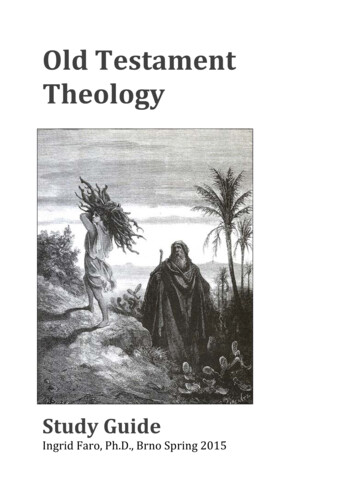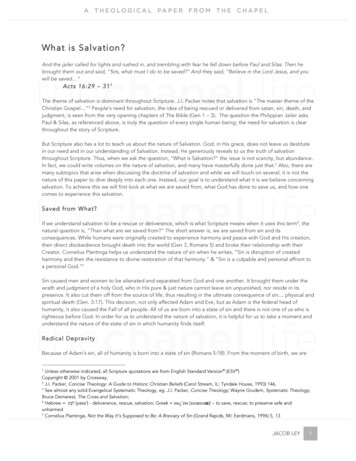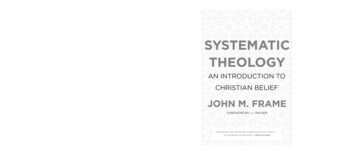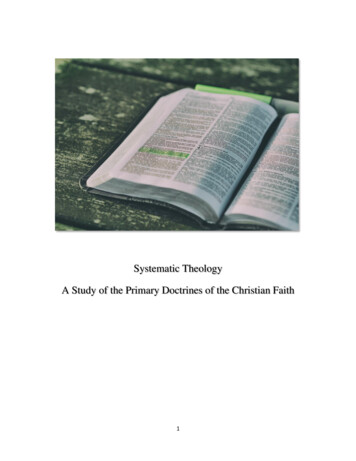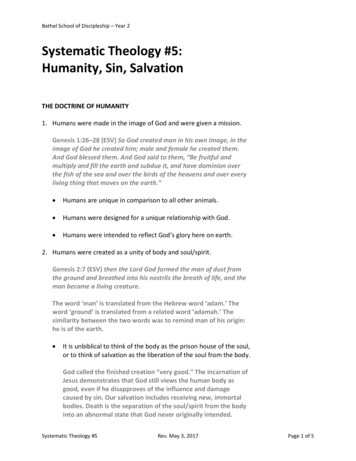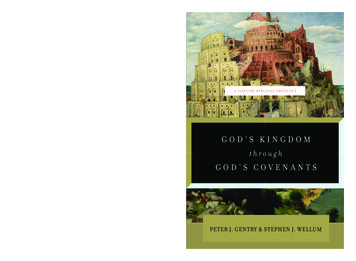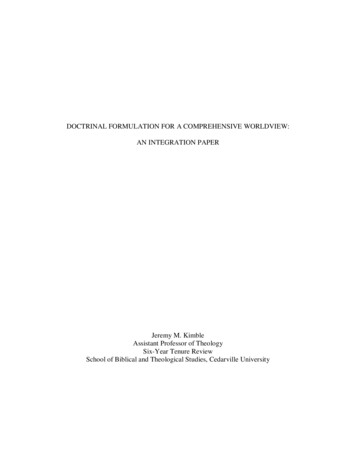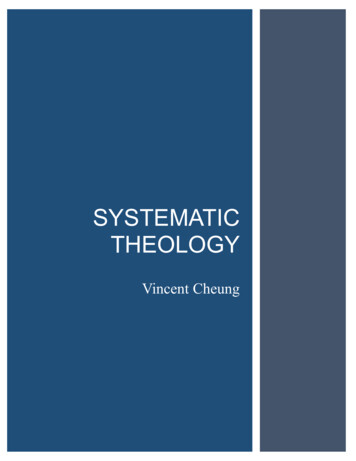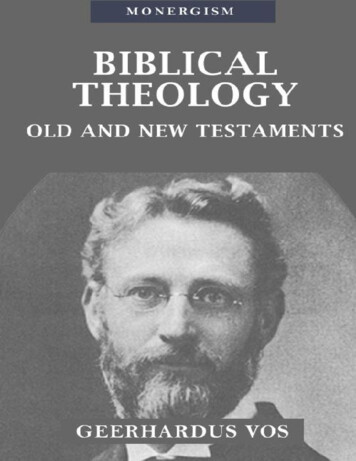
Transcription
SystematicTheologyAn Introduction toChristian BeliefJohn M. FrameFrame Systematic Theology.indd 37/30/13 7:05 PM
ContentsAnalytical OutlineForeword by J. I. PackerPrefaceAbbreviationsxixxviixxxixxxiiiPART ONE: INTRODUCTION TO SYSTEMATIC THEOLOGY1. What Is Theology?2. The Lord3. God’s Lordship as a Unique Worldview31436PART TWO: THE BIBLICAL STORY4. The Lord’s Covenants5. The Kingdom of God6. The Family of God5587102PART THREE: THE DOCTRINE OF GOD7. The Acts of the Lord: Miracle8. The Acts of the Lord: Providence, Part 19. The Acts of the Lord: Providence, Part 210. The Acts of the Lord: Creation11. The Acts of the Lord: God’s Decrees12. God’s Attributes: Love and Goodness13. God’s Attributes: Righteousness and Holiness14. The Problem of Evil15. God’s Attributes: Knowledge16. God’s Attributes: Power, Will121141172184206231257282304335viiFrame Systematic Theology.indd 77/30/13 7:05 PM
viiiCONTENTS17. God’s Attributes: Lord of Time35918. God’s Attributes: Lord of Space, Matter, Light, and Breath38319. God’s Attributes: The Self-Contained God40520. God, Three in One42121. The Three Are God44622. Father, Son, and Spirit475PART FOUR: THE DOCTRINE OF THE WORD OF GOD23. God and His Word51924. God Speaks to Us in Events and Words53425. God’s Written Words56226. The Nature of Scripture59427. From God’s Lips to Our Ears63228. From the Text to Our Hearts665PART FIVE: THE DOCTRINE OF THE KNOWLEDGE OF GOD29. God and Our Knowledge69730. Perspectives on Human Knowledge71831. Justifying Claims to Knowledge73132. Resources for Knowing748PART SIX: THE DOCTRINE OF ANGELS AND DEMONS33. Angels and Demons771PART SEVEN: THE DOCTRINE OF MAN34. Man in the Image of God78335. Human Responsibility and Freedom80936. Sin845PART EIGHT: THE DOCTRINE OF CHRIST37. The Person of Christ87738. The Work of Christ899Frame Systematic Theology.indd 87/30/13 7:05 PM
CONTENTSixPART NINE: THE DOCTRINE OF THE HOLY SPIRIT39. The Holy Spirit40. Calling41. Regeneration and Conversion—Subjective Salvation42. Justification and Adoption43. Sanctification44. Perseverance and Assurance45. Glorification9239349449649839981009PART TEN: THE DOCTRINE OF THE CHURCH46. The Church47. The Task of the Church48. The Means of Grace49. The Sacraments1017103210471060PART ELEVEN: THE DOCTRINE OF THE LAST THINGS50. Heaven and Hell51. The Events of the Last Days10751086PART TWELVE: THE DOCTRINE OF THE CHRISTIAN LIFE52. How Then Shall We Live?Appendix A: TriadsAppendix B: GlossaryBibliographyIndex of Scripture ### John Muether to create. ###Index of Subjects and Names ### John Muether to create. ###Frame Systematic Theology.indd 91101111711251150116711687/30/13 7:05 PM
Frame Systematic Theology.indd 107/30/13 7:05 PM
Analytical OutlinePART ONE: INTRODUCTION TO SYSTEMATIC THEOLOGY1. What Is Theology?A. Long and Short DefinitionsB. Theology as ApplicationC. Kinds of TheologyD. Theological Method2. The LordA. The Centrality of Divine LordshipB. Opponents of Lordship TheologyC. The CovenantD. ControlE. AuthorityF. PresenceG. Perspectives on Our Covenant LordH. Lordship and Knowledge3. God’s Lordship as a Unique WorldviewA. The Lord Is AbsoluteB. The Lord Is TripersonalC. The Lord Is TranscendentD. The Lord Is ImmanentE. Relations between Transcendence and ImmanenceF. Epistemological ParallelsG. The Lord Is CreatorH. ConclusionPART TWO: THE BIBLICAL STORY4. The Lord’s CovenantsA. Genres of Biblical LiteratureB. Narrative and WorldviewC. The Eternal Covenant of RedemptionxiFrame Systematic Theology.indd 117/30/13 7:05 PM
xiiANALYTICAL OUTLINED. The Universal CovenantE. The Edenic CovenantF. The Covenant of GraceG. God’s Covenants with NoahH. God’s Covenant with AbrahamI. God’s Covenant with Israel under MosesJ. God’s Covenant with DavidK. The New CovenantL. Covenants and PerspectivesM. Living in God’s Covenant5. The Kingdom of GodA. The Two AgesB. God the KingC. Christ the KingD. The Gospel of the KingdomE. Law and GospelF. One Kingdom or Two?G. Life in the Kingdom6. The Family of GodA. The Fatherhood of GodB. Father and Mother?(1) What Would a Female God Be Like?(2) Feminine Images of God in Scripture(3) Theological Importance of Masculine ImageryC. Living in God’s FamilyPART THREE: THE DOCTRINE OF GOD7. The Acts of the Lord: MiracleA. Defining Miracle(1) Miracle and Natural Law(2) Immediacy(3) Attestation of Prophecy(4) A More Biblical DefinitionB. Have Miracles Ceased?C. Miracle and Apologetics(1) Are Miracles Possible?(2) Is There Sufficient Evidence for Believing in Biblical Miracles?(3) Are Miracles Evidence for the Christian Faith?Frame Systematic Theology.indd 127/30/13 7:05 PM
ANALYTICAL OUTLINExiii8. The Acts of the Lord: Providence, Part 1A. Providence and MiracleB. Providence and God’s Control(1) Efficacy(2) Universalitya. The Natural Worldb. Human Historyc. Individual Human Lifed. Human Decisionse. Sinsf. Faith and SalvationC. Summary Passages9. The Acts of the Lord: Providence, Part 2A. GovernmentB. PreservationC. RevelationD. Concurrence10. The Acts of the Lord: CreationA. Defining CreationB. Creation and WorshipC. Creation and God’s LordshipD. Creation and RedemptionE. Creation out of NothingF. The Six DaysG. The Age of the EarthH. Evolution11. The Acts of the Lord: God’s DecreesA. God’s PlanB. The Decrees and God’s LordshipC. Historical ElectionD. Eternal ElectionE. ReprobationF. The Order of the Decrees12. God’s Attributes: Love and GoodnessA. GoodnessB. Love(1) The Language of Love(2) The Extent of God’s LoveFrame Systematic Theology.indd 137/30/13 7:05 PM
xivANALYTICAL OUTLINE(3) God’s Saving Love(4) God’s Love and His LordshipC. GraceD. Common Grace and God’s PatienceE. Covenant LoveF. CompassionG. Other Forms of God’s Goodness13. God’s Attributes: Righteousness and HolinessA. God’s Righteous DeedsB. God’s JealousyC. God’s HatredD. God’s WrathE. God’s Holiness14. The Problem of EvilA. The Nature of EvilB. Some Good Things about EvilC. Evil and God’s Agency15. God’s Attributes: KnowledgeA. God’s KnowledgeB. God’s Knowledge and His LordshipC. OmniscienceD. God’s Knowledge of the Future(1) God’s Knowledge of the Future in General(2) God’s Foreknowledge of Free Human Decisions and Actions(3) Passages Alleged to Teach Divine IgnoranceE. God’s Knowledge of PossibilitiesF. God’s Knowledge of Contingencies: Middle KnowledgeG. God’s WisdomH. God’s Mind16. God’s Attributes: Power, WillA. God’s OmnipotenceB. What God Can’t DoC. Definitions of OmnipotenceD. Omnipotence and RedemptionE. Power and WeaknessF. God’s WillG. Decree and PreceptH. Does God Desire the Salvation of All?Frame Systematic Theology.indd 147/30/13 7:05 PM
ANALYTICAL OUTLINExvI. Which Is the Real Will of God?J. A Third Will?17. God’s Attributes: Lord of TimeA. God’s InfinityB. God’s EternityC. Scripture on God and Time(1) God’s Temporal Omnipresence(2) God’s Unchangeability(3) A God Who Relents(4) How Is God Unchanging?(5) Unchangeability and Temporal OmnipresenceD. Some Modern Views(1) Process Theology(2) Futurism18. God’s Attributes: Lord of Space, Matter, Light, and BreathA. God’s Immensity(1) Explicit Scripture Texts(2) An Ethical Focus(3) Biblical Personalism(4) Lordship and SpaceB. God’s Spatial OmnipresenceC. God’s IncorporealityD. Theophany and IncarnationE. God’s InvisibilityF. God’s Glory(1) The Glory-Theophany(2) Glory as God’s Presence(3) God’s Glory in Creation(4) God’s Reputation(5) Glory and the TrinityG. God’s Spirituality(1) Power(2) Authority(3) Presence in Blessing and Judgment(4) The Spirit in Redemptive History19. God’s Attributes: The Self-Contained GodA. God’s AseityB. Does God Have Feelings?C. Can God Suffer?Frame Systematic Theology.indd 157/30/13 7:05 PM
xviANALYTICAL OUTLINE20. God, Three in OneA. Trinitarian BasicsB. God Is One(1) God and the Gods(2) Contemporary Critiques of Monotheism(3) God Is SimpleC. God Is Three(1) Plurals(2) Hypostatizations(3) Divine Persons in the Old Testament(4) Triads in the Old Testament(5) Old Testament Triads of Divine Beings(6) The Divine Persons in the New Testament21. The Three Are GodA. Taking Jesus’ Deity for GrantedB. Christ, the Covenant LordC. Christ, the Son of GodD. Jesus, the ChristE. Jesus Christ Is God(1) John 1:1(2) John 1:18(3) John 20:28(4) Acts 20:28(5) Romans 9:5(6) 2 Thessalonians 1:12; Titus 2:13; 2 Peter 1:1(7) 1 Timothy 3:15–16(8) Hebrews 1:8(9) 1 John 5:20(10) Philippians 2:6(11) Colossians 2:9(12) EpilogueF. Other Titles of ChristG. Other Evidence for Jesus’ DeityH. The Deity of the Holy Spirit22. Father, Son, and SpiritA. The Distinctness of the PersonsB. The Distinct Personality of the SpiritC. CircumincessioD. Mutual GlorificationFrame Systematic Theology.indd 167/30/13 7:05 PM
ANALYTICAL OUTLINExviiE. Substance and PersonsF. Ontological and EconomicG. Eternal GenerationH. Eternal ProcessionI. FilioqueJ. SubordinationK. Trinitarian ModelsL. Trinitarian AnalogiesM. Philosophical AnalogiesN. Trinity and the Lordship of GodPART FOUR: THE DOCTRINE OF THE WORD OF GOD23. God and His WordA. God’s SpeechB. God’s TruthC. God’s Word to Us(1) Controlling Power(2) Meaningful Authority(3) Personal Presence24. God Speaks to Us in Events and WordsA. Revelation through Events(1) Nature and General History(2) Redemptive HistoryB. Revelation through Words: The Divine VoiceC. Revelation through Words: Prophets and ApostlesD. Jesus, Divine Voice and Prophet25. God’s Written WordsA. The Permanence of God’s Written WordB. God’s Written Words in the Old Testament(1) The Generations(2) The Covenant Document(3) Written Prophecy(4) Wisdom(5) Respect for God’s Written Words in the Old Testament(6) Jesus’ View of the Old Testament(7) The Apostles’ View of the Old TestamentC. The New Testament as God’s Written WordsD. The Canon of ScriptureFrame Systematic Theology.indd 177/30/13 7:05 PM
xviiiANALYTICAL OUTLINE26. The Nature of ScriptureA. InspirationB. Inerrancy, Infallibility(1) Definitions(2) Biblical Basis(3) Inerrancy and Precision(4) “Qualifications” of InerrancyC. Phenomena and PurposeD. Clarity(1) Clarity and God’s Control(2) Clarity and God’s Authority(3) Clarity and God’s PresenceE. NecessityF. ComprehensivenessG. Sufficiency(1) Confessional Formulation(2) Biblical Basis(3) General and Particular Sufficiency(4) Challenges to the Sufficiency of Scripture27. From God’s Lips to Our EarsA. Copying and Textual Criticism(1) What Is an Autograph?(2) Is This Limitation Scriptural?(3) But Don’t Biblical Writers Quote Copies as God’s Word?(4) Is This Limitation an Apologetic Dodge?(5) Does This Limitation Make Inerrancy a Dead Letter?(6) Why Did God Allow the Autographs to Be Lost?(7) Why Did God Not Give Us Perfect Copies?(8) Isn’t Any Loss a Serious Loss?B. Translations and EditionsC. Teaching, Preaching, and TheologyD. SacramentsE. Confessions, Creeds, TraditionsF. Human ReceptionG. Interpretation28. From the Text to Our HeartsA. AssuranceB. Person-Revelation: The Divine WitnessFrame Systematic Theology.indd 187/30/13 7:05 PM
ANALYTICAL OUTLINExix(1) Theophany(2) Christ, the Mediator of All Revelation(3) The Work of the Holy Spirit(4) Epistemology and the Spirit’s Witness(5) The Spirit and the Sufficiency of ScriptureC. Human Beings as RevelationD. Writing on the Heart(1) The Name of the Lord(2) Heart-RevelationE. General, Special, and Existential RevelationPART FIVE: THE DOCTRINE OF THE KNOWLEDGE OF GOD29. God and Our KnowledgeA. God’s Knowledge and Man’sB. Our Knowledge of GodC. God’s Knowability and IncomprehensibilityD. Knowing God in Faith and in Unbelief(1) Knowledge in Obedience(2) Knowledge in Disobedience30. Perspectives on Human KnowledgeA. Objects of Human Knowledge(1) Divine Revelation(2) The World(3) OurselvesB. Epistemological PerspectivesC. Foundations and FoundationalismD. Theories of Truth31. Justifying Claims to KnowledgeA. Normative JustificationB. Situational JustificationC. Existential Justification(1) Knowledge, Regeneration, and Sanctification(2) Seeing Things in Biblical Patterns(3) A Corporate Existential Perspective32. Resources for KnowingA. The Personalism of the Knowledge of GodB. The HeartC. ReasonFrame Systematic Theology.indd 197/30/13 7:05 PM
xxANALYTICAL OUTLINED. Perception, ExperienceE. Emotion(1) Emotions and Decisions(2) Emotions and Knowledge(3) Emotion as a Perspective(4) Emotion and Theology(5) Cultivating Godly EmotionsF. ImaginationG. WillH. Habits, SkillsI. IntuitionPART SIX: THE DOCTRINE OF ANGELS AND DEMONS33. Angels and DemonsA. Nature and Work of AngelsB. Angels and MenC. Satan and DemonsD. Living with the Angels: A SermonPART SEVEN: THE DOCTRINE OF MAN34. Man in the Image of GodA. The Image of God(1) Control (Kingly Office)(2) Authority (Prophetic Office)(3) Presence (Priestly Office)B. Man as God’s SonC. Male and Female(1) Both Men and Women Are Made in God’s Image(2) Men and Women Are Equally in the Image of God(3) Sexual Differentiation Itself Images God(4) Men and Women Equally Represent God(5) SummaryD. Body, Soul, and SpiritE. Dichotomy and TrichotomyF. Creationism and TraducianismG. The Creation of Adam and EveH. The Historicity of Adam and Eve35. Human Responsibility and FreedomA. Responsibility as AccountabilityB. Responsibility as LiabilityFrame Systematic Theology.indd 207/30/13 7:05 PM
ANALYTICAL OUTLINExxiC. Responsibility and AbilityD. Excursus on AbilityE. FreedomF. Critique of LibertarianismG. Creaturely Otherness, Integrity, and SignificanceH. Divine and Human CreativityI. Models of Divine and Human Agency36. SinA. Man’s Original GoodnessB. The Nature of SinC. The Origin of SinD. God’s Response to the FallE. The Effects of the Fall(1) Guilt(2) Punishment(3) CorruptionF. Temptation and SinG. Are Believers Totally Depraved?PART EIGHT: THE DOCTRINE OF CHRIST37. The Person of ChristA. Christ-CenterednessB. The Deity of ChristC. The Humanity of ChristD. The IncarnationE. Jesus’ Virginal ConceptionF. The Hypostatic UnionG. Living with Two NaturesH. Communication of AttributesI. Christ the Image of God(1) Control (Kingly Office)(2) Authority (Prophetic Office)(3) Presence (Priestly Office)38. Thez Work of ChristA. Jesus’ Offices(1) Prophet(2) Priesta. For Whom Did Christ Die?b. Intercession(3) KingFrame Systematic Theology.indd 217/30/13 7:05 PM
xxiiANALYTICAL OUTLINEB. The States of ChristC. Union with Christ(1) Election(2) Adoption(3) RedemptionPART NINE: THE DOCTRINE OF THE HOLY SPIRIT39. The Holy SpiritA. Who Is the Spirit?B. What Does the Spirit Do?C. The Spirit in the Lives of Believers(1) Baptism in the Spirit(2) Filling of the Spirit(3) Fruit of the Spirit(4) Gifts of the Spirit(5) Miracles(6) Prophecy(7) Tongues(8) Healings40. CallingA. The Ordo SalutisB. Perspectives on the Application of RedemptionC. Effectual CallingD. Applications of God’s Call41. Regeneration and Conversion—Subjective SalvationA. Regeneration(1) Regeneration in the Old Testament(2) The Johannine Teaching(3) Paul on Regeneration(4) A Second Meaning of Regeneration(5) Regenerate InfantsB. Faith(1) Definition of Saving Faith(2) Saving Faith Is a Gift of God(3) Faith and Good Works(4) The Role of Faith in Salvation(5) Faith in the Christian Life(6) Faith, Hope, and Love(7) The Necessity of FaithFrame Systematic Theology.indd 227/30/13 7:05 PM
ANALYTICAL OUTLINExxiiiC. Repentance(1) Repentance and Salvation(2) Repentance and the Christian Life42. Justification and AdoptionA. Righteousness(1) The Nature of Justification(2) A Legal Declaration(3) A Constitutive Declaration(4) The Ground of Justification(5) The Instrument of Justification(6) Justification and Sanctification(7) Recent Controversy over Justificationa. The New Perspective on Paulb. Norman ShepherdB. Adoption(1) Relation of Adoption to Other Doctrinesa. Regenerationb. Faithc. Justification(2) Privileges of Adoption43. SanctificationA. HolinessB. Definition of SanctificationC. Definitive SanctificationD. Progressive SanctificationE. Means of Sanctification(1) God’s Law(2) The History of Redemption(3) Our Personal ResourcesF. Spiritual Exercises and Simple Obedience44. Perseverance and AssuranceA. PerseveranceB. Assurance of SalvationC. Grounds of Assurance45. GlorificationA. Present GlorificationB. Future GlorificationC.Partaking in the Divine NatureD.Glory with God and with ChristFrame Systematic Theology.indd 237/30/13 7:05 PM
xxivANALYTICAL OUTLINEPART TEN: THE DOCTRINE OF THE CHURCH46. The ChurchA. Old Testament BackgroundB. The Nature of the ChurchC. Visible and InvisibleD. Local, Regional, UniversalE. ImagesF. AttributesG. MarksH. Church Government47. The Task of the ChurchA. The Church and the KingdomB. God’s Mandates for the ChurchC. Specific TasksD. Ministries of the Church48. The Means of GraceA. The Idea of a Means of GraceB. The WordC. FellowshipD. Prayer49. The SacramentsA. BaptismB. The Mode of BaptismC. Infant BaptismD. The Lord’s SupperE. Table Fellowship with GodF. The Experience of the Lord’s SupperPART ELEVEN: THE DOCTRINE OF THE LAST THINGS50. Heaven and HellA. The Intermediate StateB. The Eternal StateC. Eternal Blessing of Believers (Heaven)D. Eternal Punishment of Unbelievers (Hell)51. The Events of the Last DaysA. AmillennialismB. PostmillennialismFrame Systematic Theology.indd 247/30/13 7:05 PM
ANALYTICAL OUTLINExxvC. PremillennialismD. Arguments for AmillennialismE. Arguments for PostmillennialismF. Arguments for PremillennialismG. PreterismH. The Already and the Not YetI. Eschatology and the Christian LifePART TWELVE: THE DOCTRINE OF THE CHRISTIAN LIFE52. How Then Shall We Live?A. Lordship and Ethics(1) How God Governs Our Ethical Life(2) Necessary and Sufficient Criteria of Good Works(3) Biblical Reasons to Do Good Worksa. The History of Redemptionb. The Authority of God’s Commandsc. The Presence of the Spirit(4) Types of Christian Ethics(5) What Really Matters(6) Factors in Ethical Judgment(7) Perspectives on the Discipline of Ethics(8) Interdependence of the PerspectivesB. The Ethical LifeC. The Lord’s CommandsFrame Systematic Theology.indd 257/30/13 7:05 PM
ForewordR EFOR M ED T H EOLOG Y PR E SEN TS itself (as Roman Catholic theology alsodoes) as a comprehensive, thoroughgoing embodiment of universal Christian truth.The taproot for all versions of it has been John Calvin’s catechetical treatise for preachers and adult believers, the fifth and final edition of his Institutes, where the wealthof truth uncovered by Martin Luther’s biblical minings is consolidated for all time.Since then, three parts of the world have made major contributions to the Reformedheritage, each engendering its own conflicts and loyalties. England saw the sixteenthand seventeenth-century Puritan development, from William Perkins to John Owen,exploring life in Christ in and through the Holy Spirit; nineteenth-century Hollandproduced the Kuyperian theology of human and Christian culture within a Reformedframe; and the twentieth century witnessed, within the conservative Presbyterianworld, the ongoing quest for Reformed methodological authenticity, in which B. B.Warfield, Geerhardus Vos, J. Gresham Machen, and Cornelius Van Til are, by commonconsent, the leading names. I’d like to think that tomorrow’s Reformed leaders willadd John Frame’s name to that list; I believe they should.The church must ever seek in its theological life to verbalize biblically affirmedrealities and biblically approved attitudes—to make clear to itself what is and will beinvolved in holding fast to these things and living in their light and power, and to detectand reject inauthentic alternatives. That, of course, involves interacting both with thewords and ways of the surrounding world and with the heritage of the Christian past.In the nature of the case, theology is a cumulative enterprise in which each generation of thinkers stands on the shoulders of those who went before, and reflects on itsintellectual legacy in the spirit of a grateful, though critical, trustee. This requiresdiscernment and may call for challenges to what is customary, for the church’s heritagecontains, along with truth and wisdom, limitations and mistakes and anachronisms, sothat it can not only inspire but also mislead our minds and put damaging blinders onthem. That is why wise men say that the Reformed church must always be reforming(ecclesia reformata semper reformanda; actually, the Latin is passive: “needs always to bereformed” is the precise translation). To the church’s head, our living Lord Jesus Christ,the church’s well-being is a matter of abiding concern, so those who theologize in hisname should always see active service in and to the church as part of their vocation.xxviiFrame Systematic Theology.indd 277/30/13 7:05 PM
xxviiiFOREWORDConcern for a clear theological method and concern for the church’s well-being areevident as two driving forces in John Frame’s theological work, all of which anchorsitself within the territory mapped out by the Westminster Standards. In the world ofseparatist American Presbyterianism, he has sometimes come under fire as a left-wingreformist; in the wider world of mainstream conservative Protestantism, which has theReformed heritage at its center, he is not as well known as he should be; but where hiswork is noticed, he is recognized as one of the most clearheaded and best disciplinedbiblical systematists of our time. His status here will become apparent to anyone whotakes time to study this, his magnum opus, and it is a matter for thanksgiving that hehas been able to crown his career as teacher and writer by composing it. He seems tohave feared lest it be unwittingly uneven, because he had not taught in the seminaryclassroom all the topics he covers here—but he need not have worried. At every pointhis probing, lucid, patient, thoroughly resourced reflections display mastery, and theeasy friendliness of his style becomes the spoonful of sugar that makes the mixturego down into mind and heart in the pleasantest way possible, every time.Clearly, the ideal reader whom Frame has in mind is the seminary or Bible collegestudent who will one day be teaching in the church, and his aim throughout is to renderthat person a humble, faithful, Bible-soaked, Christ-loving, reverent communicator ofthe revealed truth of God. The thoroughness with which he searches the Scriptures,the firmness of his insistence that on all matters canonical Scripture must be allowedto speak the last word, and his quickness to discern where this is not being done, or notdone well enough, give his discussions hermeneutical significance that his academicpeers will appreciate. Also, his presentations reveal something yet more precious ina teacher of theology, namely, an awareness that it is natural for the children of Godto want to know all they can learn about their heavenly Father. Over and above hisprimary audience, Frame writes for all who have this instinct and are willing to thinkabout divine things at some length.The goal of theology, as Frame understands it (and there is nothing out of the ordinary here), is the organized knowledge of God and ourselves together, in the contextof our past, present, and future lives. This knowledge, which is both cognitive andrelational, must be drawn, first to last, as we have already observed, from the writtenWord of God—the Bible. Frame sees, and stresses, that since God is infinite and weare finite, our knowledge of him and of our relationship to him cannot be other than,and so at best will be, perspectival, that is, made up of a set of distinct but correlatedperspectives, each providing a thematic focus complementary to what other perspectivesyield. Anyone who has driven, or can imagine driving, the sixty miles or so around thefoot of Washington State’s mighty Mount Rainier, stopping every few miles to viewthe mountain from a new angle, will appreciate what this means. Within this carefully constructed commitment to perspectivalism as the scaffolding, Frame opts fora regular procedure of what may be called heuristic triadic analysis, which opens upeach point of theological substance by subdividing it into three. The procedure seemsto grow out of the demonstrable advance in understanding that Frame first achievedFrame Systematic Theology.indd 287/30/13 7:05 PM
FOREWORDxxixby his archetypal analysis of God’s lordship (that is, his sovereignty) in terms of control, authority, and presence. While not categorically claiming a connection betweentriperspectivalism and the truth of the Trinity, Frame habitually practices it as anunfailing didactic technique (in his own words, “a good pedagogical device, a set ofhooks on which to hang the doctrines of the faith”). He is a master at it, and presentsus with no fewer than 110 cogent triadic analyses in the course of this work, all neatlylisted at the back as Appendix A. The proof of the pudding, they say, is in the eating,and there is no doubt that Frame’s triads, all achieved by separating out situational /normative / existential factors in the reality, or phenomenon, under analysis, do againand again bring into his discourse a degree of clarity that is quite stunning. Familiar,faded doctrines become fresh; fuzzy doctrines become precise; dull doctrines becomestimulating and exciting. History will perhaps see this technique as John Frame’s majorcontribution to the conceptual toolkit with which systematic theology works.Briefly, now: Systematic Theology brings together, slims down, sums up, and augmentsall the wisdom contained in Frame’s four-volume Lordship series. It is a worthy climaxto the life’s work of one who has only ever sought to be a faithful servant of Christ,teaching in his church. It is a privilege to celebrate its appearing and to commend itfor serious study. I guarantee that the dividends of such study will be uniformly high.Thank you, John Frame, for this superb gift.J. I. PackerBoard of Governors’ Professor of TheologyRegent CollegeVancouver, British ColumbiaFrame Systematic Theology.indd 297/30/13 7:05 PM
Frame Systematic Theology.indd 307/30/13 7:05 PM
PrefaceSOM E V ERY GR E AT systematic theologians never wrote systematic theologies,among them B. B. Warfield. Warfield never desired to write one. He thought the Systematic Theology of his predecessor Charles Hodge was quite adequate, and for himselfhe preferred to write scholarly and popular works on specific doctrinal subjects. Hisstature as a theologian is no less for this decision. Nevertheless, I would not be surprisedto hear that most teachers in the field would dearly love to have the opportunity tosummarize their thoughts in a full-scale systematics. I belong to the latter group, so Iam immensely thankful to God for the opportunity to write this book, an elaborateexposition of the teaching of Scripture as I understand it.When my friend and editor John J. Hughes suggested this project, I did not resist,but he sought to motivate me nonetheless. He pointed out that in my case the taskmight be easier than for others, because I have already written big systematic theologybooks in some areas,1 and I have written an introductory summary of theology, including topics not covered in the larger books.2 Certainly these earlier books have been agreat help to me in writing this one, and readers of those books will see here a basiccontinuity of thought and approach. They might even suspect (rightly) that in manyplaces some text has been cut and pasted from those past books. But I have tried todo more than to summarize the big books and to expand chapters of the smaller one.Rather, I have tried to rethink everything to make it more biblical, clear, and cogent.For me, biblical is always the operative word. Systematic theologies, to be sure, areoften full of historical lore about the theological battles of the past and present, andthat is needed up to a point. Readers will misunderstand the doctrine of the Trinity,for example, if they don’t see how the technical terms substance and person emergedfrom controversy over Sabellianism and Arianism. And I want also to include enoughhistorical discussion to express proper gratefulness to those teachers whom God hasraised up in past generations. Neither my theology nor anyone else’s gets its contentexclusively from an individual encounter with the Bible. And I don’t want my readersto think I am claiming anything like that for my own work.Yet the Bible is the most important thing. Only the Bible is the written Word of Godmade available to us. It must have the final word in all historical and contemporary1. DKG; DG; DCL; DWG.2. SBL.xxxiFrame Systematic Theology.indd 317/30/13 7:05 PM
xxxiiPREFACEcontroversies. So the most important aspect of theological work is to present to readerswhat the Bible says. And if some choice is to be made (as it must) of what to include andexclude, that choice must be on the basis of what is best suited to express the Bible’steaching to contemporary readers.My use of this criterion has led to a systematic theology that is somewhat less historical in focus than other volumes. I have also written less than they about controversiesamong contemporary academic theologians, because frankly I do not think many ofthese controversies are helpful in bringing the Bible’s teaching to Christian believers.I will have more to say on these subjects in chapter 1 of this book.I am thankful to all who have helped to make this work possible. First among theseis my dear wife, Mary, and our children, Debbie, Doreen, Skip, Justin, and Johnny.Thanks also go to the administration, faculty, and student body of Reformed Theological Seminary, who have given me constant and gracious support. P&R Publishing,which has given me many opportunities over the years to expound biblical doctrine,has now allowed me the privilege of publishing this volume. I am especially thankful to John J. Hughes, my longtime friend, who shepherded this volume through thepublishing process and who has helped me much on my past writing projects. In thisbook he has worked together with Karen Magnuson, an outstanding copyeditor whohas
PART ONE! INTRODUCTION TO SYSTEMATIC THEOLOGY 1. What Is Theology? 3 2. The Lord 14 3. God's Lordship as a Unique Worldview 36 PART TWO! THE BIBLICAL STORY 4. The Lord's Covenants 55 5. The Kingdom of God 87 6. The Family of God 102 PART THREE! THE DOCTRINE OF GOD 7. The Acts of the Lord: Miracle 121 8. The Acts of the Lord: Providence .
